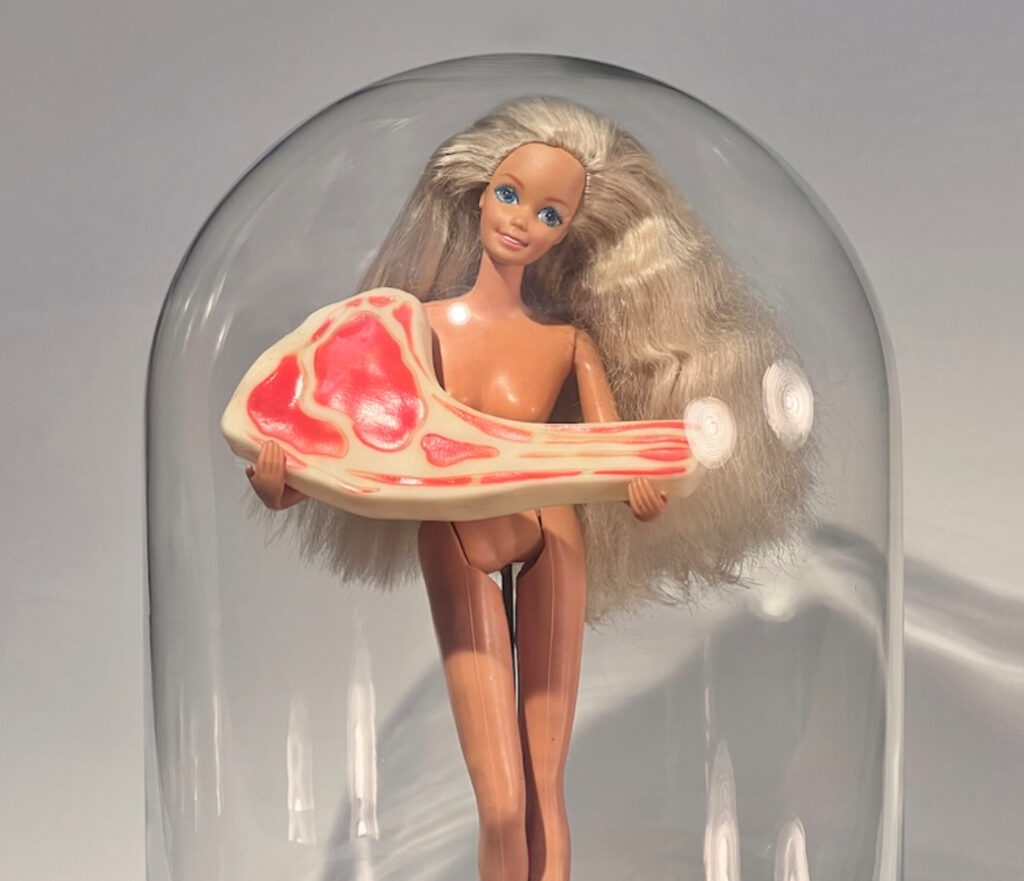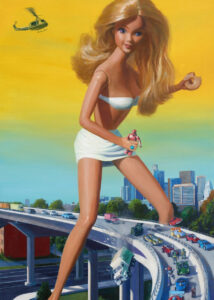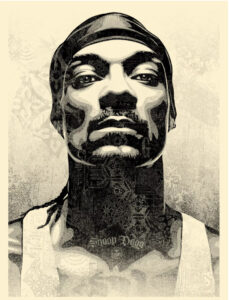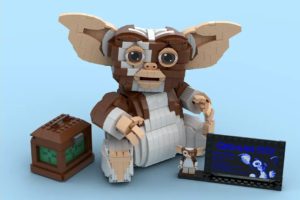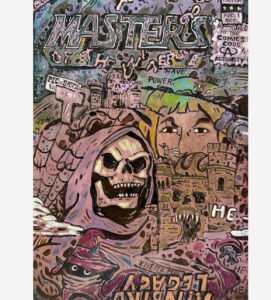
In a city built on dreams and spectacle, Mattel’s 80th Anniversary Group Exhibition at Corey Helford Gallery delivers both in abundance—but with unexpected nuance. Titled “Toys As Art, Art Inspired By Toys,” the exhibition isn’t just a retrospective of plastic, packaging, and nostalgia. It’s a meditative collision between memory and medium, celebrating eight decades of cultural imagination refracted through the lens of contemporary art.
Spanning two massive gallery floors in the heart of Downtown Los Angeles, the show doesn’t simply look back on Barbie, Hot Wheels, and He-Man—it reinterprets them, deconstructs them, and in some cases, weaponizes them. This isn’t pop art. It’s post-pop prophecy, filtered through 80 years of play, politics, gender dynamics, and commercial symbolism.
80 Years of Play: A Cultural Touchstone, Not Just a Toymaker
Founded in 1945, Mattel has grown from a post-war startup to a global cultural cornerstone, shaping not just what children play with, but how generations dream, express, and self-define. From Barbie’s evolving body politics to Hot Wheels’ obsession with velocity and design, Mattel toys have become aesthetic objects in their own right—symbols of childhood but also battlegrounds for identity, aspiration, and representation.
The genius of the Corey Helford curation lies in recognizing that artists have long been engaging with these toys—often subconsciously—as totems of societal projection. In “Toys As Art,” they are invited to do so explicitly.
The Gallery as Playground: A Curated World of Reimagined Icons
Upon entering the exhibition, visitors are greeted by a floor-to-ceiling kinetic Barbie chandelier, composed of disassembled doll limbs arranged into a spiraling helix, lit by soft pink LEDs. The piece, created by multimedia sculptor Camille Vell, sets the tone: discomfort and delight coexisting in plastic form.
Further into the gallery, each Mattel brand becomes its own thematic vignette:
Barbie: Beyond the Mirror
Barbie is the undisputed star of the show, not because of nostalgia alone, but because of the endless conceptual mutations she invites. Paintings by LA-based surrealist Natalie Shau depict Barbie in oil-slicked Renaissance portraits, reimagining her as a patron saint of girlhood, femininity, and artificial beauty.
Across the gallery, a mirrored chamber installation titled “Dreamhouse Redux” invites viewers to navigate an endless reflection of Barbie architecture—each room a glitchy echo of the last, blurring the lines between virtual and real, childhood and adulthood.
Barbie isn’t just idolized here—she’s interrogated.
Hot Wheels: Velocity, Scale, and Urban Myth
Artists take the kinetic energy of Hot Wheels and run wild with it—sometimes literally. A standout is “Looping Through Time” by kinetic artist Zhu Wen, where diecast cars orbit on magnetic tracks, their movement mapped by real-time digital projections that resemble a futuristic traffic simulation.
Elsewhere, sculptor Gregory Anhalt creates a post-apocalyptic cityscape from melted Hot Wheels chassis, reimagining them as urban fossils—symbols of a society racing toward collapse.
Masters of the Universe: Myth Meets Muscle Memory
The sword-and-sorcery franchise gets a heavy metal makeover via ink illustrations and bronze miniatures, transforming He-Man, Skeletor, and Teela into mythological archetypes. One large-scale painting, “By the Power of Yesterday,” depicts a weary He-Man removing his armor, his sword transformed into a rusted relic—a meditation on masculinity in decline.
Other pieces delve into the homoerotic undertones of the franchise, celebrating its camp and coded subtexts through glitter-encrusted busts and drag reinterpretations.
Polly Pocket, American Girl, and Other Miniature Realities
Not to be overlooked, smaller-scale Mattel lines like Polly Pocket and American Girl receive poetic treatment. Miniaturist Maya Linne recreates Polly Pocket sets in hyper-real dioramas of modern domestic unease—kitchens with flickering stoves, doll bedrooms with digital screens displaying anxiety stats.
Meanwhile, American Girl dolls are rendered in large-format photo-portraits, placed in historical scenes like Vietnam War protests and ’90s rave culture. The effect is jarring and moving—a quiet revolution through soft-sculpted rebellion.
A Soundtrack to Play: Sonic Interpretations of Nostalgia
One of the most immersive elements of the show is its sonic design, created in collaboration with electronic musician TOKiMONSTA, who composed a looping ambient score using sampled toy sounds—squeaks, clacks, chimes—layered into meditative tracks.
Each gallery zone has its own audio cue. The Hot Wheels space pulses with bass; Barbie’s room echoes with music box lullabies slowed down to a crawl; Masters of the Universe trembles with synthetic thunder. It’s not just what you see—it’s how it makes you feel, soundtracked in waves of emotion.
Beyond the Toys: A Reflection of the Now
What makes this exhibition soar is not just the art—but its resonance. The toys are merely entry points. What lies beneath is a deep excavation of cultural myth, consumer memory, and the paradoxes of play.
The artists ask questions like:
- What does it mean to aspire to Barbie in 2025?
- Is speed still freedom in an age of climate dread?
- Are our childhood heroes aging with us—or leaving us behind?
These inquiries are not academic. They’re emotional truths—told through plastic, pigment, and vision.
The Crowd: Fans, Critics, Children, and Collectors
During opening night, the gallery is alive with unlikely intersections. Fashion students photograph retro doll outfits. Art critics scribble notes on brushed-metal Hot Wheels sculptures. Parents point out their favorite childhood toys to Gen Alpha children. There’s a sense of convergence: a timeline collapsing into shared memory.
Mattel’s marketing has always excelled at multigenerational appeal—but here, through the filter of fine art, the brand’s legacy becomes collective experience. Not commodified. Communal.
Limited Edition Prints, Collaborations, and Merch (of Course)
No retrospective of toys is complete without a shop—and the gallery’s curated merch capsule doesn’t disappoint. Visitors can purchase:
- Limited edition screenprints by featured artists
- A reissued 1986 “Crystal Barbie” rendered in translucent resin
- Exclusive toy-themed zines, including essays and sketches from the artists
- A collectible 12” vinyl featuring TOKiMONSTA’s gallery score
But even the merchandise feels thoughtful, restrained. There is no excess—only extensions of the dialogue.
Impression
“Toys As Art, Art Inspired By Toys” doesn’t ask you to suspend disbelief. It asks you to reconsider belief entirely—about childhood, about design, about the silent ways we form identity around play.
Mattel’s 80th anniversary could have been a marketing exercise. Instead, it became a mirror—fragmented, glittering, and occasionally cracked—that reflects who we are when we think no one’s watching.
The toys are familiar. But the way they’re rendered here—through paint, sculpture, light, and sound—feels utterly new.
No comments yet.

